Emerald Ash BOrer
Agrilus planipennis Fairmaire, a beetle native to Asia, was first detected in Michigan in 2002. Evidence suggests that the beetle was established in Michigan for years prior to its discovery. Emerald Ash Borer (EAB) has since been detected in many states, and also in Ontario and Quebec, Canada. In addition to spreading by natural means, EAB can be transported to new areas in infested firewood, timber, and nursery stock. This beetle has been responsible for the loss of millions of ash trees in North America.
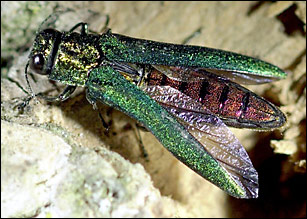

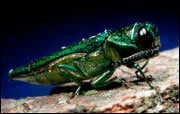
Host
In North America, EAB is known to infest all species of ash (Fraxinus spp.). Ash can be recognized by the presence of compound leaves which are arranged opposite of one another on the branches.
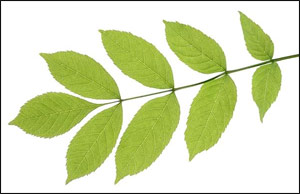
Ash Leaf
Biology
Eggs are laid between layers of bark and in bard crevices. Larvae hatch in about one week and bore into the tree where they feed on the inner bark and phloem, creating “S” shaped galleries. Larvae go through four feeding stages, and then excavate a pupal chamber in the fall, where they will overwinter as prepupae. Pupation occurs in late spring, and adults begin to emerge through “D” shaped exit holes in May and early June. Adults will remain active until the end of summer.
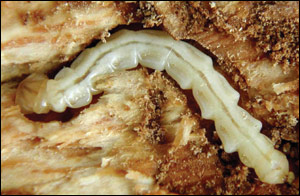
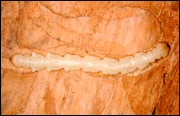
EAB Larva
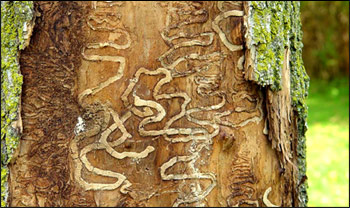
S Shaped Gallery
look for year-round
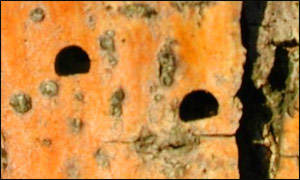
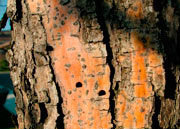
D Shaped Emergence Holes
Not EAB
This commonly encountered beetle, [show image] the six spotted green tiger beetle, Cicindela sexguttata, is often mistaken for EAB due to its similar appearance. It is a predator of small insects and is frequently found on hiking trails. There are other insects often mistaken for EAB.
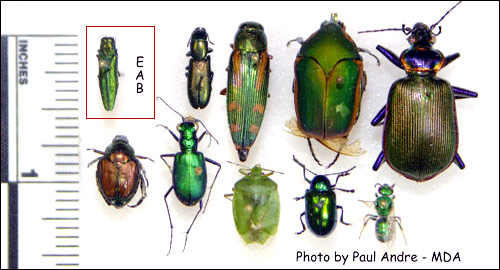
Symptoms and signs
New infestations are difficult to detect, as damage to the tree may not be apparent for up to three years. Symptoms of an infestation can include branch dieback in the upper crown, excessive epicormic branching on the tree trunk, and vertical bark splits. Woodpecker damage is sometimes apparent.
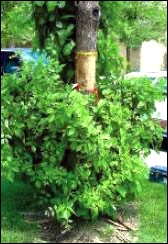
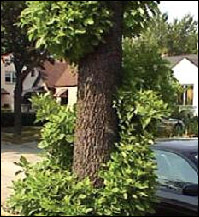
Trunk Branching
look for year-round
Other Stressors
Ash may also be stressed by drought, diseases such as ash yellows, and by native wood-boring insects like the [show image} redheaded ash borer, Neoclytus acuminatus, (fabricius) which creates a round emergence hold.
Report
If you think you have found an Emerald Ash Borer, please contact one of these offices in your area:
- LLBO DRM
- State Forestry or other Natural Resource Agency
- Cooperative Extension Office
- USDA Animal and Plant Health Inspection Service
- U.S. Forest Service
- Or call toll free: 1-866-322-4512
![]() Information courtesy of US Department of Agriculture.
Information courtesy of US Department of Agriculture.
Contact Us
[email protected]
[email protected]
(218) 335-7418
Physical Address
15756 State 371 NW, Cass Lake, MN
When entering the DRM compound, we are located in the new forestry building along the back fence; offices inside.
Mailing Address
190 Sailstar Drive NW, Cass Lake, MN
| Name | Title | Phone |
|---|---|---|
| Karnes, Keith | Forester | 335-7418 |
| Hare, Dave | Forestry Technician | 335-7407 |
For more information
www.emeraldashborer.info
Arrest the Pest Hotline (651) 201-6684 or (888) 545-6684
http://www.mda.state.mn.us/invasives















 Division of Resource Management
Division of Resource Management